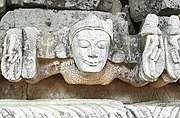Undivided Goalpara district
The Undivided Goalpara district is an erstwhile district of Assam, India, first constituted by the British rulers of Colonial Assam.
| Part of a series on the |
| History of Assam |
|---|
 |
|
Proto-historic |
|
Late Medieval |
|
Modern |
|
Contemporary |
| Categories |
|
Establishment
Historical background
The region was part of Kamarupa during in the first millennium, subsequently a part of Kamata kingdom and finally Koch Hajo in the late 16th century. But after beginning of Ahom-Mughal conflicts (1619-1682), it became a part of the Bengal Subah of the Mughal Empire; though it was in Ahom control for about three years around 1658,[1] it was not a regular part of Ahom territory.[2] Under the Mughals, it was constituted as Sarkar Dhekuri,[3] and it passed into East India Company control along with Bengal in 1765 and it fell under the Rangpur administration. As a part of the East India Company's frontier policy a special administrative region, called "North-Eastern Parts of Rangpur", was constituted sometime after 1816, with David David Scott appointed as its Civil Commissioner in January 1822.[4]
Constituting Goalpara
In anticipation of a rapture with the Burmese, the eastern frontier was placed under a military command, with David Scott appointed as an Agent of the Governor-General to oversee the political aspect of the Northeast Frontier and the Assam affairs.[5] Within the first month of the First Anglo-Burmese War (March 1824), the regions to the east of Rangpur, Kamrup and Darrang (under the erstwhile Ahom kingdom, then under Burmese occupation).[6] By October 1824, the newly acquired region came under administrative control of David Scott, the Chief Commissioner of "North-Eastern Parts of Rangpur"[7] and the historical grouping of the Goalpara, Kamrup and Darrang (largely congruous to the erstwhile Koch Hajo) called Western Assam (later Lower Assam) became apparent.[8] The Burmese abandoned the Ahom capital Rangpur in 1825 and following the Treaty of Yandabo of February 1826, the whole of the Ahom kingdom, except the Sadiya and the Bengmara regions, fell under direct British control and came to be called Eastern Assam. Western and Eastern Assam were placed under two commissioners, the Senior and Junior Commissioners, with the Senior Commissioner having certain overriding powers over the Junior Commissioners. The Junior Commissionership was abolished in 1828.
In March 1833 the erstwhile "Northeast Rangpur" was constituted as the Goalpara district.[9] At the end of the Bhutan War in 1865 the British took complete control of the Duars, and the portions adjoining Goalpara were added to it.
Notes
- "In 1658, the Ahoms advanced again, occupied Goalpara and held it for three years but were compelled to retreat before Mir Jumla's army". (Dutta 1995, p. 8)
- " Ahom territory (i e, by and large, the Brahmaputra Valley without the Goalpara district)."(Guha 1983, p. 9)>
- (Dutta 1995, p. 8)
- (Bannerjee 1992, pp. 4-5)
- (Banerjee 1992, p. 5)
- (Banerjee 1992, pp. 5–6)
- (Bannerjee 1992, p. 6)
- "The territory on the (west)—Biswanath to Goalpara—was known as western Assam; but another name—Lower Assam—gradually came into use" (Bannerjee 1992, p. 9)
- (Bannerjee 1992, p. 53)
References
- Bannerjee, A C (1992). "Chapter 1: The New Regime, 1826-31". In Barpujari, H K (ed.). The Comprehensive History of Assam: Modern Period. IV. Guwahati: Publication Board, Assam. pp. 1–43.CS1 maint: ref=harv (link)
- Dutta, Birendranath (1995). A Study of the Folk Culture of the Goalpara Region of Assam. Guwahati, Assam: University Publication Department, Gauhati University.CS1 maint: ref=harv (link)
- Hunter, William Wislon (1879). A Statistical Account of Assam. 1. Trübner & co. Retrieved 2012-12-13.CS1 maint: ref=harv (link)
- Guha, Amalendu (December 1983), "The Ahom Political System: An Enquiry into the State Formation Process in Medieval Assam (1228-1714)", Social Scientist, 11 (12): 3–34, doi:10.2307/3516963, JSTOR 3516963